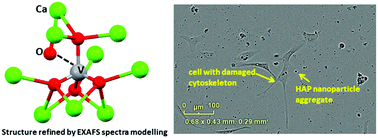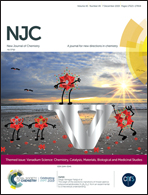Synthesis, characterization and in vitro anti-cancer activity of vanadium-doped nanocrystalline hydroxyapatite†
Abstract
Vanadium drugs have been known for more than a century, but clinical translation has been hampered by unfavorable pharmacokinetics and lack of reliable delivery systems. Because of considerable interest in hydroxyapatite (HAP; Ca10(PO4)6(OH)2) nanoparticle-based drug delivery vehicles, particularly for the treatment of bone disease, and the well-known chemical similarity between phosphate and vanadate, we report the first detailed studies of the reactivity under biologically relevant conditions, as well as the in vitro anti-cancer activity of vanadate-substituted HAP. Nanocrystalline vanadium-doped HAP (up to ∼10% mol V relative to P) was prepared by partial substitution of phosphate with vanadate. This substitution does not significantly alter the HAP crystal lattice (X-ray powder diffraction), but surprisingly, the V(V) local structure is not tetrahedral. X-ray absorption spectroscopy showed that it has a [V(O)2(O′)2(OH)]4− coordination mode, with two short and two long V–O bonds from vanadate, and a weak interaction with an OH− ligand from the HAP structure. Also surprising is the partial reduction of V(V) to V(IV) within the crystal lattice of HAP under biomimetic conditions (5.0 mM ascorbate, pH 7.4, 24 h at 310 K, XANES and EPR spectroscopies). Both original and ascorbate-reduced V-doped HAPs are strongly cytotoxic to cultured human bone cancer cells (SW1353) when HAP nanoparticles are dispersed into cell culture medium. Partial reduction of V(V) to V(IV) within HAP decreased V leaching into cell culture medium but increased the cytotoxicity, which suggested that the activity is not just due to extracellular V release, but rather involves uptake of the nanoparticles. These preliminary results warrant further studies of V-doped HAP for bone cancer treatments.

- This article is part of the themed collection: Vanadium Science: Chemistry, Catalysis, Materials, Biological and Medicinal Studies


 Please wait while we load your content...
Please wait while we load your content...